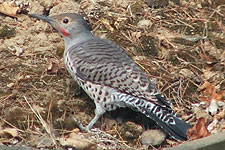Wildlife

Northern Flicker
Audio: Listen Now
Scientific Name: Colaptes auratus
Primary Source: Janice Pappas
Photo Source: Marc Thornsbury
Audio Source: Cornell Lab of Ornithology
More Info: USDA Forest Service
The northern flicker is a larger member of the woodpecker family. The yellow-shafted flicker has a red patch on its neck, yellow feathers on the inside of its wings, and (on males) black markings from the beak to below the eye. The red-shafted flicker has a black patch on its neck, pinkish feathers on the inside of its wings, and (on males) has red markings from the beak to below the eye.
These birds are found in wooded areas with stands of dead trees, open open areas, clear-cut or burned areas, or forest edges. While they may occassionally "drill" for insects in dead trees like a woodpecker, they are more often seen on or near the ground. You can find northern flickers all over Bingen Point, but they are most common in the forested areas around Bingen Lake.
The majority of the flicker's diet is comprised of insects, especially ants. They may also eat termites, beetles, caterpillars, fruits, and berries with the latter comprising over half its meals in the fall and winter. Occassionally they may eat seeds and nuts. The flicker is the only woodpecker in North America that commonly finds its food on the ground.
Flickers build their nests in holes in trees, telephone poles, or birdhouses. Breeding occurs from February to July. A clutch is commonly six to eight eggs in size. Both the male and female incubate the eggs and later feed the young. Flickers in the north have one brood a year while those in the south may have two.

